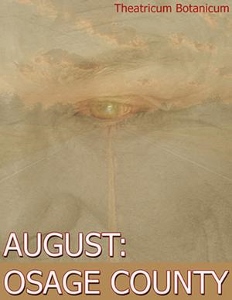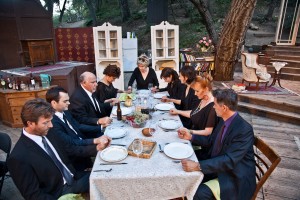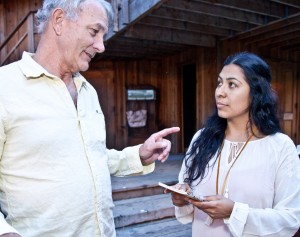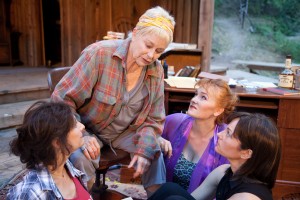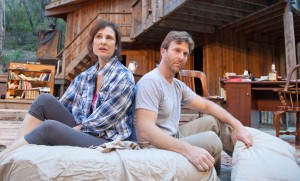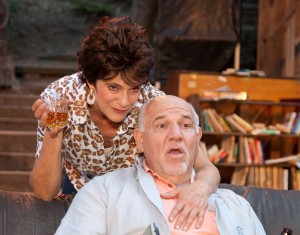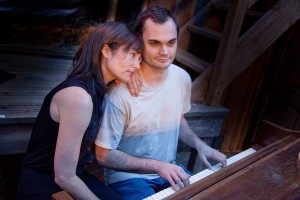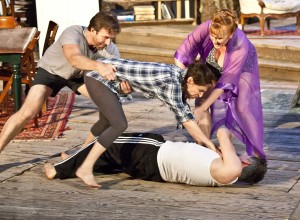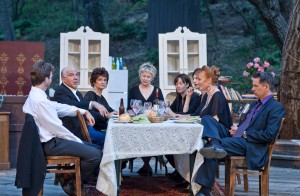THE AMERICANS
Tracy Letts wrote a bleak comedy in 2007 that sold a lot of tickets, won a bunch of prizes and ensured his writing career at least a footnote in the big books. August: Osage County is about three generations of a familiarly fucked-up American family – you got your moral weakness, your addiction, sexual predation, incest. Secrets are dangerous; self-deception is bad; don’t drink so much. If you like that kind of joke, you will get a lot of it here. There are several meaty, squirmy scenes of dysfunction strewn up to and away from a crowd-pleasing central dinner-party set piece. The show is very funny and sometimes moving, with sprawling breadth and a handful of choice roles. It’s the most successful entry to date in the Going Home to Take Care of Mom and Dad genre that surged in the mid-90s, when Boomers’ parents started getting Alzheimer’s. But at three hours plus, it’s also an hour overwritten.
In Cat on a Hot Tin Roof, Tennessee Williams breaks the Bible Belt family down to a rich proof of tangents and variables, all specific and nuanced. Big Daddy’s bowel cancer is both a catalyst and an engine. Brick drinks to drown his love for his dead friend – an insoluble dramatic obstacle. Maggie’s desire for and faith in Brick might just resurrect a worthy family. But it’s just as likely Brother Man and Sister Woman could accidentally-on-purpose thwart her and bring them all to ruin with their greed and mendacity. There’s a lot of clear, specific storyline in this family, and therefore a lot to invest in. I want to see this family, this business, this town, this world get on its feet again.
In the less imaginative, more cynical Osage County, I mark time waiting for the Responsible Sister to turn inevitably into her mother, and to see whether the Left-at-Home Sister might finally leave the hometown. The late-arriving Less Developed Sister is for obvious reasons less interesting. The Abusive Manipulator Mother is a knockout part for an actor, lots of villainy to chew with her cancerous mouth, but as a character she pretty much just abuses and manipulates. What she wants from anybody is hard to see, and all anyone wants from her is to be left alone; so her journey’s basically circular, and so is the play. There are thirteen characters altogether, and half of them, while interesting foils to the central figures, serve little function to the plot.
The play would have more impact if it lost some redundant scenes – moments of revelation are repeatedly softened, the surprise given away as Letts uses dramatic irony to engage the audience as participant rather than horrified spectator. We wait for characters to be informed of what we already know. Our investment therefore is in their reaction to new information, not in our own. This is fine once or twice but Letts really doesn’t change it up for the many individual narratives, and for me this trick gets old fast. What I might gain in terms of complicity with unsympathetic characters doesn’t compensate for the loss of the catharsis I find in more direct storytelling.
In a related issue, the play’s structure and character arcs become ever less disciplined as the play goes on. Letts’s more efficient 1996 play, Bug, also lacked a clear endgame of character goals well into the final moments; here, Letts doesn’t bother to separate climax from exposition from falling action in a third act that’s thematically blatant and not dramatic enough. Eventually people sit and drink and talk directly about the metaphors (America and T.S. Eliot come up a lot). At this point the use of a Native American savior character becomes less allegorical grace note than blunt force trauma. The script stays pretty funny, the rote set-up-and-punch-line situational jokes only occasionally feeling a little borscht-belt via prime time TV. But story stops showing me a good time with the end of the second act, and my patience is spent by the top of the third.
The good news is that if you want to watch a long, Pulitzer Prize-winning black comedy about a family that might look like yours, only wittier, there’s a very good production going on in Topanga. Mary Jo DuPrey directs a strong cast in a physically engaging show that uses almost the entire available Theatricum Botanicum space – the stage, plus the balconies, porches, stairwells and doorways of attendant buildings. In an outdoor amphitheater where a big oak tree sticks up from the middle of the living room, the rules of space are that the rules stay fluid. It works well when your staging is arranged around emotional beats; then you can let the actors create and sustain given circumstances. (No set designer is credited for any of the theater’s shows this summer, but Zach Moore provides simple, serviceable lights.)
As the drug-addled elderly woman, Ellen Geer is always sharp, well-timed, physically and emotionally convincing. She sustains what must be an exhausting amount of energy dragging this character up and down stairs, cocking hips and eyes, rolling on the floor, drawling and slurring. As her dramatically extraneous sister, Melora Marshall gives a technically excellent performance, a marvel really – they, and Tim Halligan as an alcoholic poet, are the most successful at building large, not to say broad, characterizations that exploit the script’s larger-than-life elements.
Poorly cast the last time I saw her, as a raging queen in Antony and Cleopatra at A Noise Within, Susan Angelo is very good here as the daughter with the most to lose. As her sisters, Abby Craden and Willow Geer are effective, but have less to do because as written their parts are still underfleshed. Among the supporting actors, Alan Blumenfeld and Paul Stroili are particularly effective, providing gravity and a grounded sense of stakes.
Overall the production steamrolls through much of what might feel tedious or redundant in the writing, and there are lovely moments peppered throughout – the sight of an opiated geriatric dancing to Eric Clapton while a cop waits to give her life-and-death news is not one Mary Jo DuPrey, Ellen Geer, and Paul Stroili are going to let me forget anytime soon.
photos by Miriam Geer
August: Osage County
Will Geer’s Theatricum Botanicum
1419 N Topanga Canyon Boulevard in Topanga
ends on September 27, 2015
for tickets, call 310-455-3723 or visit www.theatricum.com
